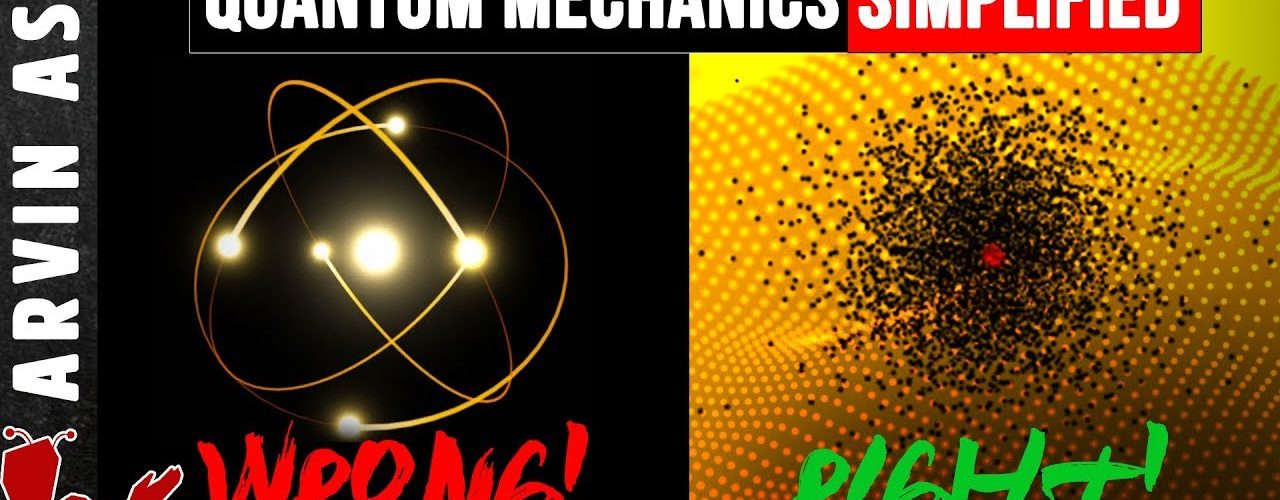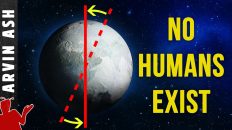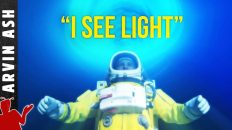Signup for your FREE trial to The Great Courses Plus here: http://ow.ly/ilR330pHoFu
Quantum physics simplified. Spookiness explained. What is the true nature of reality at the smallest scales?
There is probably nothing that is more jaw-dropping and confusing in all of science than the discipline of quantum mechanics or QM. This is the set of physics theories that describes the behavior of subatomic particles.
There is so much misleading information that has been written on this subject, that for most people it is very hard to separate science facts, from pseudoscience speculation.
And given how important this QM is, for example it is the basis of all modern microelectronics – from your cell phone, to your gps, to your computer, to your solar cell – I think it is extremely important for you to be able to separate quantum physics facts from fiction.
Let me give you a few examples of (quote unquote) facts that you will read about, view, or be told:
1) QM justifies free will because everything is random
2) Consciousness is a fundamental component of physics and the universe.
None of these statements are supported by quantum mechanics. So what is quantum mechanics? How does it actually work? And can it be explained simply in 10 minutes? The answer to the last question is yes…and the other answers are coming up right now…
I hope to dispel the profound misunderstanding and misconceptions about quantum mechanics, by explaining as simply as possible how quantum mechanics actually works. So you can judge for yourself when you are being told misleading information.
I ask you to watch this video all the way through because if you go straight to the conclusions, I am afraid, you may still get the wrong ideas, and be misinformed by people who would take advantage.
So let’s start with how quantum mechanics evolved. In 1801, British physicist Thomas Young performed a double slit experiment which showed that light was a wave, because it formed an interference pattern as a wave would. So for most of the 19th century light was considered a wave.
However, in 1887, German Physicist Heinrich Hertz discovered something called the photoelectric effect. This is a phenomenon where light can knock off electrons from atoms. But it was found this phenomenon was not triggered by certain colors regardless of the intensity, but only by higher frequencies of the light. So ultraviolet rays resulted in this effect but light at the red end of the spectrum did not, no matter how bright you made it. This was not the way a classical wave was supposed to behave.
This mystery was solved by none other than Albert Einstein who proposed that light was not a wave, but came in packets of energy, or particles – you know them photons. These were packets of waves he said. And the energy of these particles was proportional to its frequency of the wave. So higher frequency light, corresponding to the blue and violet end of the visible scale carried more energy than lower frequency light corresponding to the red end of the spectrum. By the way, Einstein won the Nobel prize for this. It was not for relativity.
So Young and Einstein’s results seemed to be in conflict. Was light a wave or a particle?
But then in 1909, G. I. Taylor performed a double slit experiment such that only one photon was emitted through the double slits at a time. So what was seen on the screen. Well, if you shine a single photon through a double slit, you will see a single point on the other side. No mystery there. But then as more and more photons are shot one at a time through the slit millions of time, a pattern emerges that looks like the same interference pattern that Young had demonstrated more than a hundred years earlier.
So individual photons look like particles, but a bunch of photons behave together like a wave. So photons appear to be both a wave and particle. This was confusing.
This experiment was later performed with electrons which also showed the same pattern.
But people were perplexed as to what a wave of an electron actually means. We can understand water waves because we can see them. They oscillate up and down. But what is actually happening with an electron. This was a mystery.
In classical mechanics, Newton’s second law, Force equals mass times acceleration makes a mathematical prediction regarding the path a physical object will take. If you know its initial conditions, you can always figure out where the object will be.
Something that showed a similar mathematical description of the wave of electrons was needed. Something that showed the location of the electron, or the shape of its wave function.
In 1925, Austrian Physicist, Erwin Schrodinger, invented the Nobel Prize winning equation that revealed the shape of this wave function. It was the quantum mechanical equivalent of Newton’s law, and it probably the most important equation in quantum mechanics.
We are not going to derive this formula, but I just want you to understand one thing about it.
Unlike Newton’s equation, it is not deterministic. It is not straightforward like Newton’s equations. It evolves over time. The Psi in the equation, which looks like a trident, is a wavefunction. Psi gives us the shape of the wave, as a function of x.
Schrodinger himself struggled with the interpretation of this wave function, that is, what does it actually mean? His interpretation was that it was the charge density of the electron over space. But this was actually not correct, and did not work.
In 1926, German physicist, Max Born, worked out that the psi function was related to probability. He said, it represented the probability of finding the electron in any one point in space.
So for example, this equation describes the behavior of electrons in an atom. It shows how the electrons occupy certain orbitals and what their shapes are. These shapes are really the probability densities of finding the electron in any particular spot.
And unless you measure it, you can only come up with a probability of finding the electron at any particular radius.
The most accepted interpretation of the wave function, called the Copenhagen interpretation, was pioneered by two of the founders of quantum mechanics Werner Heisenberg and Neils Bohr. This interpretation says that until a measurement is made, this equation tells us that the electron is in all the potential positions at once.
This interpretation basically says that the wave function is not a real thing. It only describes mathematical probabilities. The only thing that matters is measurement – that is when the position, energy, or other property of the particle can be known.
So when the measurement takes place, that’s when we say that its wave function has collapsed, because only at that point can we ascertain where where electron is or what its properties are.
So for example, if the wave function for a particular system looks like this. The probability of finding the electron at this location and this location would be highest, and here and here would be lowest.
But you won’t really know where it is until you measure it, and you are unlikely to find the electron in the same spot if you repeat the test.
And this so-called collapse of the wave function is where the main confusion occurs when it comes to quantum mechanics. There is no equation that outlines exactly how this collapse occurs after measurement. This has been called the measurement problem of quantum mechanics.
I’ve been careful to use the word measurement instead of “observation” – which many textbooks and physicists use interchangeably. The problem with the word observation is that it implies looking with your eyes, which requires an observer, and a consciousness.
But observation in quantum mechanics does not require eyes. It is simply a measurement. So what is a measurement? Doesn’t it require a measurer? No, a measurement is an interaction of two physical systems.
What does this mean? When an electron bounces off an atom, that’s a measurement. An observation in physics does not mean a conscious observer. Just about anything can be an observation. If an atom in superposition interacts bumps into another atom, that’s an observation, and the wave function will collapse.
When any two systems interact, that can collapse probability waves. There is no eyes, humans, or consciousness necessary.
So getting back to the double slit experiment, when a single photon hits the screen, it collapses the probability wave of the photon. It shows up as a particle. That same photon is acting as a wave prior to hitting the screen, because it hasn’t been measured yet. The screen measures it.
So as a wave, it has a non-zero probability to show up anywhere on the screen where the wave would strike the screen. So as we shoot thousands and millions of photons one at a time on the screen, the probability distribution become apparent in the pattern shown. If enough photons are fired, you get a distribution exactly as predicted by the wave function.
Now, you saw in a earlier video I made, about how the pattern changes to a double line pattern of photons instead of waves, if we make the measurement of the photon before it strikes the screen.
So knowing what I just told you about wave collapse, it should be obvious now why this double line pattern shows up. We are collapsing the wave by measuring it before it hits the screen. So now, this photon is no longer in superposition. It is no longer a probability wave, and not subject to the Born probabiity.
So the photon is a distinct particle before it strikes the screen, and no longer behaves like wave. So naturally, it is going to strike the screen and show a pattern like a particle would.
The measurement made was a purely physical measurement. It would not matter if anyone or any animal looked at the measurement, took a photo of the measurement. All of that makes no difference in the collapse of the wave.
Overall what we can see is that the fundamental underpinnings of nature are probabilistic not deterministic.
Does this justify free will? Well, we have to be careful to extrapolate what happens at the quantum level to the deterministic world of our everyday experience. Just because free will implies that your decisions are not deterministic, and quantum mechanics implies that the properties of small particles are also not deterministic, the two are not related. There is no science linking the two.
We may or may not have free will, but quantum mechanics does not tell us anything about it. And consciousness is not required to collapse of the wave function. The universe exists and will continue to exist, whether we are here to observe it or not.
Now I have not covered everything in quantum mechanics, like quantum tunneling or entanglement. These are big subjects that I will tackle in future videos. For now, I just wanted to convey the basics of how quantum mechanics works, and dispel some of the common misunderstandings
This video is sponsored by Great Courses Plus
Guys, I am delighted to tell you that this video is sponsored by great courses Plus. This is a subscription on-demand video learning service where you can enjoy lectures from some of top professors and educators in the world.
People like Dr. Don Lincoln, of Fermilab whose lectures I just watched on understanding the misconceptions of science. His lecture series was the inspiration for this video. This particular course also covers great topics that are of interest to me like the science of aliens, Does thermodynamics disprove evolution, can you go faster than light. If you want to get more in depth knowledge on any of these subject, or what I discussed today, I highly recommend great courses plus.
Use the link in the description. – right now Great Courses plus, is offering a free trial, and a discount. But be sure to use this special link.
And if you liked this video, then please share it with your friends, and give us a like. Also, if you have a question, post it below, because I try to answer all of them. I will see you in the next video my friends.







